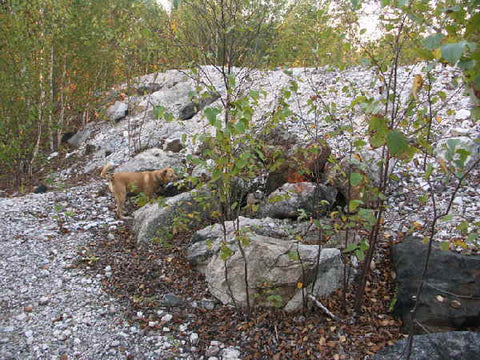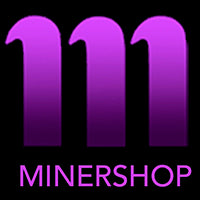Long Lake Zinc Mine - Ontario Canada
OLDEN TOWNSHIP, FRONTENAC CO., ONTARIO, CANADA.
Located in the southern part of Ontario near the town of Parham, the zinc deposit near Long Lake has attracted our interest for several years. It is relatively easy to get to from where we are (an 18 hour drive) and seemed to offer some quite remarkable specimens based on the few examples we've seen on the market. 2009 being a down year for Greenland, we decided to hop in the truck with our loyal collecting buddy (Minnie - our pure bred rock sniffing mutt) and see what was really up there.
The Long Lake zinc deposit was first discovered in 1896 by L. Benn and 100 tons of ore was recovered from a small pit. From 1897 to 1925 the property was mined using trenches and pitting - resulting in 3,442 tons of ore. In 1947 shafts were constructed, milling equipment was installed and another 1,674 tons of ore was extracted. Serious mining began in 1973 after several years of surveying and drilling. A plant had been constructed with a workshop, core-shack, compressor shed and generator house - along with crushers, conveyers, separating plant and settling pond. After extracting a total of 9,467 tons of zinc concentrate the plant was officially closed in Dec. 1974. - less than two years of operation! Today all that remains of the original operation is a large "dump" area, a few cement structures, and two fenced off adits - and LOTS of very fluorescent rocks.

One of the remaining structures on the property - probably the core-shack/office space

We arrived in the area early one day in Sept. It was quite easy to find using Google maps and a GPS (44d 41.362N, 76d 46.329W). Our first priority was to find the property owner and "check-in" (We had called earlier to arrange our visit and he asked that we simply stop by the house and let him know when we arrived). Elgin Young has owned the property for the past 40 years. He has seen the mine come and go, and has had fluorescent collectors show up on his doorstep from all over the world for the past several years. He is very collector friendly and a very nice person; let's keep it that way! Haul out your trash, fill in any holes you dig, and haul out trash left by others if you find it. Above all - get permission before visiting. This locale is simply too valuable to our hobby to lose access to.
Mr. Young's house is located at the intersection just before the mine area. We stopped by and introduced ourselves and after a pleasant conversation set off for the mine. (Note: Mar 2014 - We've heard rumors that Mr. Young has sold the property (likely true - he was getting on in age) and the new owner is not receptive to collecting - unconfirmed. If you have any further information please let us know).


Turnoff into the mine area and the gate
We rolled into the mine area and quickly decided where to make camp. We planned on staying a few nights and selected an area towards the back (which also seem to have been worked over the most). For the rest of the day we simply explored, checked a few rocks out Greenland style (BBQ grill cover), and made mental notes of areas we wanted to visit that evening to discover various glow rocks.

Minnie relaxing on our relaxing spot overlooking the marshes and pond in the distance

One of the remaining structures - probably foundation for some piece of heavy machinery

Typical dump area filled with large boulders
We made several fluorescent finds during the afternoon and piled them up in a "cache" to be checked later that evening. The sun was slowly setting so we made dinner and relaxed a while (amazing how slowly the sun sets when you're waiting for it). Once it got dark collected started in earnest. The first thing you notice is the bright blue hydrozincite everywhere on red calcite. All of the small rocks glow. We proceeded to check out the large boulders laying around on the surface and quickly determined that dozens of prior collectors had done the same. That's why they're still lying around. That evening we explored the entire dump area, marking spots which had productive boulders. It's obvious now, but the best material will be the material that no one has seen before. This means it's buried. We found it relatively easy to locate a boulder that just had its tip sticking out and determine if it had that certain glow about it. We also explored the woods area (still part of the dump, the trees have just started to overtake those areas). Several potential glow-boulders were noted in these areas also.

This might be the tip of a 6-color, 200 LB boulder - you just gotta dig it up!

Boulders are everywhere - but which ones have the right glow?
The next day we simply worked the finds we made the night before. We found several large boulders embedded in the ground and had to dig them out. A large pry bar was very helpful along with a digging rake (the other end of my Estwing hammer). A large sledge hammer then made short work of reducing the boulder to manageable chunks. And we didn't forget to fill in the gaping hole our extracted boulder left! After a hard day's work we had quite a few piles of material. The evening was spent high-grading these piles - what fun!

A typical boulder - bust off the ends to see what's inside.
Most of these are calcitized marble, often mixed with chrondrodite and diopside.
Some pieces have bright aragonite veining and/or hydrozincite.
Some are heavily metamorphisized exhibiting wavy patterns (see 1st FL pic below).
We simply left the caches in place for the next day where we could just drive the truck around and load them without having to haul them all back to the truck. Mining couldn't be easier!

Geological map of the Long Lake Zinc Mine
Things to bring (other than the ordinary stuff): Mosquito spray, big sledge hammer, big pry bar, digging tool, portable seat, food and drink, garbage bags, camping gear, DC battery charger.
SELECTED SPECIMENS
Of course when we arrived back to homebase the first thing we did was check out the haul. Below are pics of 4 of our favorite finds, showing the wide variety of minerals, patterns and colors. Note - these are all 10LB plus rocks! Not only are the colors from this area strikingly vivid, the rocks are big!

Calcite, hydrozincite, aragonite, diopside, chrondrodite (fullwave)

Chrondrodite, diopside (SW)

 Hydrozincite, chrondrodite, calcite, aragonite, diopside (SW)
Hydrozincite, chrondrodite, calcite, aragonite, diopside (SW)

